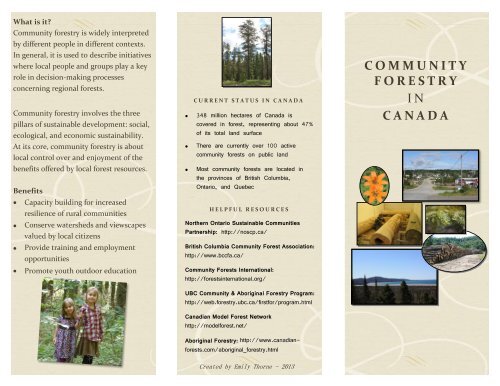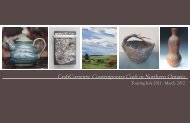Community Forestry Pamphlet - Northern Ontario Sustainable ...
Community Forestry Pamphlet - Northern Ontario Sustainable ...
Community Forestry Pamphlet - Northern Ontario Sustainable ...
Create successful ePaper yourself
Turn your PDF publications into a flip-book with our unique Google optimized e-Paper software.
What is it<br />
<strong>Community</strong> forestry is widely interpreted<br />
by different people in different contexts.<br />
In general, it is used to describe initiatives<br />
where local people and groups play a key<br />
role in decision-making processes<br />
concerning regional forests.<br />
<strong>Community</strong> forestry involves the three<br />
pillars of sustainable development: social,<br />
ecological, and economic sustainability.<br />
At its core, community forestry is about<br />
local control over and enjoyment of the<br />
benefits offered by local forest resources.<br />
Benefits<br />
Capacity building for increased<br />
resilience of rural communities<br />
Conserve watersheds and viewscapes<br />
valued by local citizens<br />
Provide training and employment<br />
opportunities<br />
Promote youth outdoor education<br />
<br />
<br />
<br />
C U R R E N T S T A T U S I N C A N A D A<br />
348 million hectares of Canada is<br />
covered in forest, representing about 47%<br />
of its total land surface<br />
There are currently over 100 active<br />
community forests on public land<br />
Most community forests are located in<br />
the provinces of British Columbia,<br />
<strong>Ontario</strong>, and Quebec<br />
H E L P F U L R E S O U R C E S<br />
<strong>Northern</strong> <strong>Ontario</strong> <strong>Sustainable</strong> Communities<br />
Partnership: http://noscp.ca/<br />
British Columbia <strong>Community</strong> Forest Association:<br />
http://www.bccfa.ca/<br />
<strong>Community</strong> Forests International:<br />
http://forestsinternational.org/<br />
UBC <strong>Community</strong> & Aboriginal <strong>Forestry</strong> Program:<br />
http://web.forestry.ubc.ca/firstfor/program.html<br />
Canadian Model Forest Network<br />
http://modelforest.net/<br />
Aboriginal <strong>Forestry</strong>: http://www.canadianforests.com/aboriginal_forestry.html<br />
C O M M U N I T Y<br />
F O R E S T R Y<br />
I N<br />
C A N A D A<br />
Created by Emily Thorne - 2013
M A I N O B J E C T I V E S O F C O M M U N I T Y<br />
F O R E S T R Y<br />
<strong>Community</strong> forestry, as it currently exists in Canada, is a practice that has been advocated<br />
over the past few decades as an innovative approach to forest management and community<br />
development. Typically, community forests share 3 primary objectives:<br />
Non-timber forest products can be harvested<br />
from community forests and redistributed locally,<br />
as value-added products.<br />
T O E N H A N C E L O C A L C O N T R O L O V E R<br />
D E C I S I O N S<br />
<strong>Community</strong> forestry enables participatory decision-making<br />
<strong>Community</strong> forestry is about fostering local control<br />
processes where citizens can express opinions and have<br />
over not only the decisions affecting use of nearby<br />
more influence than typically occurs through industrial forestry<br />
forests, but also how and where forest-derived<br />
that operates under a centralized, command-and-control<br />
benefits and products are distributed.<br />
Forest-derived benefits and products come in many<br />
system. Achieving the best possible representation of local<br />
values and interests, and easing land ownership issues are<br />
important to multi-party collaboration.<br />
Partnerships and mixed<br />
ownership models can ease<br />
land ownership and tenure<br />
issues<br />
Some communities elect<br />
community shareholder boards<br />
to represent the values of<br />
various local groups<br />
forms, often called “environmental services” and<br />
“non-timber forest products” (NTFPs). Environmental<br />
T O E N H A N C E L O C A L E C O N O M I C<br />
S U S T A I N A B I L I T Y<br />
services include clean water, clean air, wildlife<br />
<strong>Community</strong> forest initiatives create employment within the<br />
habitat, and carbon storage that provides a buffer<br />
forestry and tourism industries, in addition to creating<br />
against climate change. NTFPs are anything taken<br />
opportunities for harvesting a considerable number of non-<br />
from a forest that does not include the harvesting of<br />
trees. Mushrooms, medicinal plants, fur-bearing<br />
animals, and essential oils are examples of the<br />
timber forest products. This ensures recirculation of<br />
resources within communities and keeping more benefits at<br />
the local level.<br />
Emphasis is placed on<br />
economic value and best-end<br />
use, rather than volume<br />
Modes of production are<br />
labour-intensive as opposed to<br />
capital-intensive<br />
resources that can be used to provide local<br />
livelihoods, or be sold to provide income.<br />
T O E N H A N C E S U S T A I N A B L E F O R E S T<br />
M A N A G E M E N T<br />
When a product is harvested and modified before sale<br />
or use, it becomes a value-added product.<br />
Manufactured wood products, maple syrup, woven<br />
baskets and the greenery in floral bouquets are just<br />
some of the value-added products.<br />
<strong>Community</strong> forests can be sustainably managed through<br />
ecologically sensitive forestry practices that recognize and<br />
place value on all ecosystem components that comprise the<br />
local forest.<br />
Respecting whole ecosystems including air, water, soil,<br />
wildlife, and plants within a forest can ensure conservation<br />
and enable sustained use for generations to come



